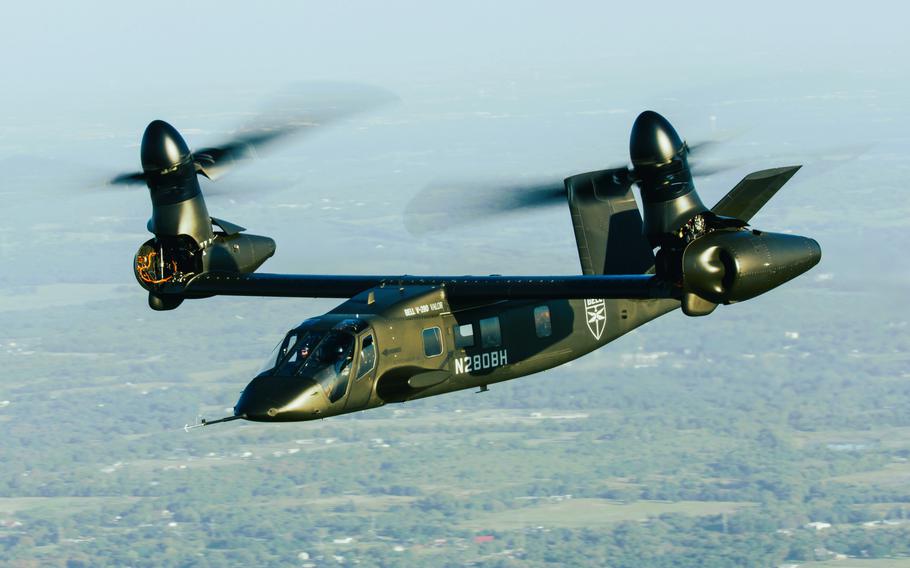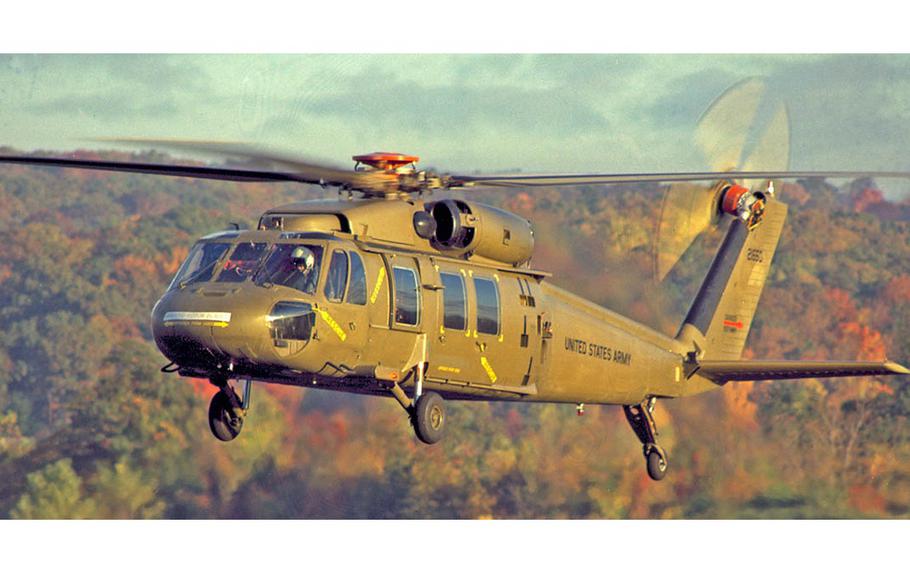
The V-280 Valor, prototype of the Army’s planned MV-75 Future Long-Range Assault Aircraft that’s designed to replace the UH-60 Black Hawk. (Bell)
The Army has announced the future of air assault, choosing the “Screaming Eagles” of the 101st Airborne Division at Fort Campbell, Ky., as first in line to fly the new MV-75 tiltrotor.
The MV-75 is designed to sweep into battle at more than 320 mph, skimming over the treetops before seeming to stop mid-air as its rotors pivot to a vertical for landing.
Up to 14 soldiers could spill out into a firefight. Litters carrying wounded could be loaded for the return flight. In less than five minutes, the MV-75 could lift off, shift to horizontal flight, and race miles away from danger.
“This aircraft changes how we move forces — it changes the geometry of ground combat,” Gen. James Mingus, the Army vice chief of staff, said last week.
But that future isn’t here yet.
The 101st won’t get the MV-75 tiltrotor until 2030 — though Army officials said they hope to shave a year or more off the timeline through acquisition reforms announced last month by Secretary of Defense Pete Hegseth.
The MV-75 is part of the Army’s Future Vertical Lift (FVL) program to replace all of its helicopters by mid-century.
While the MV-75 was given a boost by Mingus’ announcement, the FVL program has already seen one project cancelled at a cost of $2 billion and others being questioned as outdated by the Army’s recently announced “transformational rebalancing” of its air assets.
Hegseth announced in April that the Army would review its warfighting abilities with an eye toward downplaying manned helicopter use and instead focusing on the use of uncrewed drones.
“The Army must transform at an accelerated pace,” Hegseth said.
To be determined
The MV-75 aircraft is so new, it doesn’t even have an official name.
The prototype from Bell and Lockheed Martin is called the V-280 Valor.
At the Army Aviation Association of America conference, Army officials said the new aircraft would carry the designation “MV” for “multi-mission vertical” takeoff and landing.
The numerical change from 280 to 75 is a salute to 1775, the year the Army was founded.
In the past the Army has named its helicopters after Indian tribes. Even the UH-1 Huey is officially named the “Iroquois” although the name didn’t stick like Black Hawk and Apache.
Will the new tiltrotor follow or break the naming tradition?
“That is TBD — to be determined,” said Col. Marty Meiners, a spokesman for the 101st Airborne Division.
The MV-75 is the first aircraft the Army announced in 2009 that it planned to field by mid-century under the Future Vertical Lift program.
The program was launched in 2009 to find replacements for U.S. military helicopters that the Pentagon said had aged more rapidly than anticipated due to the high tempo of deployments and operations in the wars against terror following the 9/11 attacks.
The pipeline for new designs had also become so extended that the military primarily relied on updated versions — blocks — of existing designs, some of which were more than 50 years old.
“I don’t want my grandchildren flying the AH-64 Apache Longbow Block 80,” Army Maj. Gen. Anthony Crutchfield quipped at the Army Aviation Association of America conference in 2011.
The Army plan called for replacing its aging inventory of UH-60 Black Hawk, CH-47 Chinook, AH-64 Apache, and OH-58 Kiowa helicopters.
If the designs proved successful, the Pentagon said the aircraft could be adopted by other services, possibly replacing up to 25 helicopter and fixed-wing aircraft types across all branches.
Two programs were first up.
The Future Long-Range Assault Aircraft (FLRAA) competition to replace the UH-60 Black Hawk was decided in December 2022. The Army selected the V-280 tiltrotor from Bell and Lockheed Martin, beating out the SB>1 Defiant, a coaxial rotor helicopter submitted by Sikorsky and Boeing.
The win for the V-280 has the potential for $72 billion in orders from the Army. Coming in second meant the SB>1 will be displayed at the Army Aviation Museum at Fort Novosel, Ala.
The Future Attack Reconnaissance Aircraft (FARA) competition to replace the OH-58 Kiowa reached a key point in 2020 with the Bell 360 Invictus and Sikorsky Raider X chosen as finalists.
After spending $2 billion on developing the FARA, the Pentagon pulled the plug on the program in February 2024.
Pentagon officials have said that lessons learned from combat between Russian and Ukrainian forces had shown battlefield tactics had changed, particularly in the use of cheap but deadly drones. Critics argued that crewed helicopters were vulnerable to drones and shoulder-launched missiles.

The first flight in October 1974 of what would become the UH-60 Black Hawk helicopter. More than 5,500 variants have been manufactured for the U.S. military and 36 foreign countries. (Sikorsky)
Black Hawks will still fly
Until the future arrives, soldiers will go into battle, search for downed pilots, hoist stranded ship crews at sea and drop sonar on submarines much the way they have for the past half-century — with one of the 5,000 UH-60 Black Hawks and its variants built for the U.S. military.
For some, that’s just fine.
“The Black Hawk today is something like the Huey in the old Vietnam days — everybody has been in it, knows it, trusts it,” said Chief Warrant Officer 5 Barry Sledd of the 7th Infantry Division at Joint Base Lewis-McChord, Wash.
Sledd has been in the Army since 1989 and believes that modernization is a key to success on the battlefield. But so is familiarity and trust.
“I had 2000 combat hours in Iraq and Afghanistan,” Sledd said. “There were several times we were shot at and came back with bullet holes to prove it. The Black Hawk performed as advertised — it got us home.”
Sledd recalled serving with Col. Derek A. Smith when he was commander of the 16th Combat Aviation Brigade, 7th Infantry Division.
At his July 2024 retirement ceremony, Smith called out his family’s history with the Black Hawk.
“My dad was a UH-60 pilot, and he retired as a brigadier general,” Smith told the audience.
The first Black Hawk flew on Oct. 17, 1974
Black Hawk variants have flown in every U.S. military conflict since the Invasion of Grenada in October 1983. Another 36 nations have purchased the Black Hawk for their militaries, rescue or emergency services.
The UH-60 isn’t going away.
Until — or unless — the MV-75 wins over congressional budget writers and troops in the field, the Black Hawk is available to step up — or even step in.
“The reliability of the aircraft, the affordability of the aircraft, having an aircraft that is proven, that has been fielded, is great to have,” said Jay Macklin, business development director for Sikorsky, which manufactures the Black Hawk.
“Keeping the Black Hawk reduces risk for future vertical lift needs.”